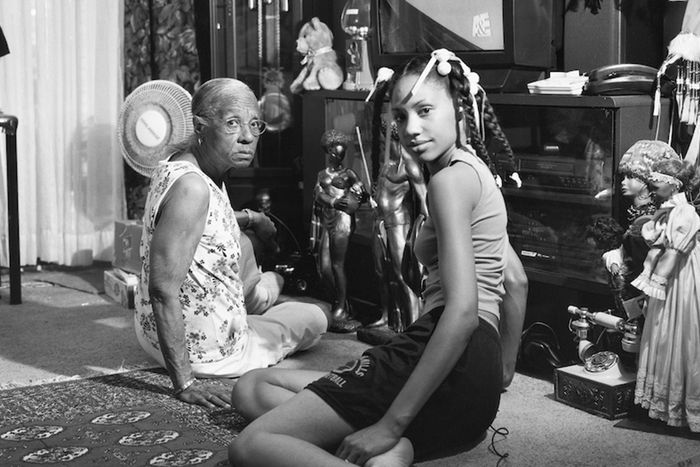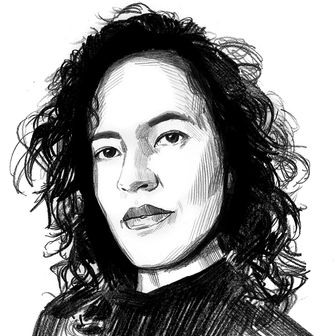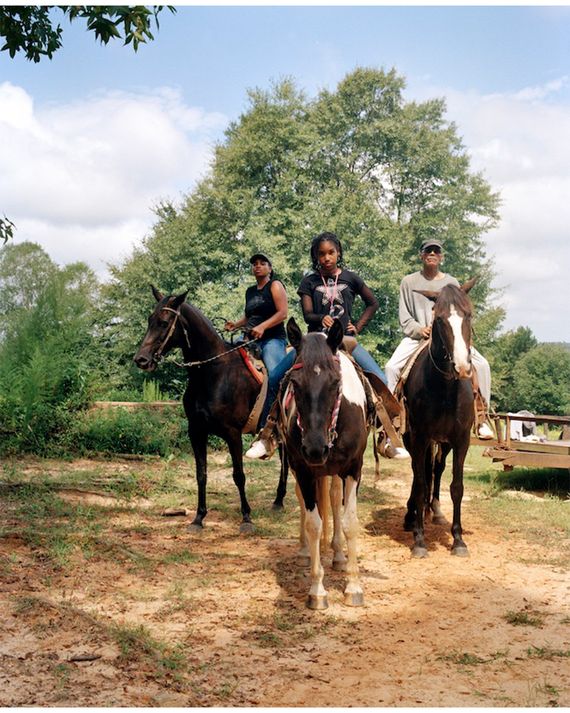
As long as she could remember, LaToya Ruby Frazier’s hometown had been in trouble. She was born in Braddock, Pennsylvania, in 1982, too late for the theaters, shops, and stable jobs at the steel mill that her Grandma Ruby remembered and just in time for the decline of American steel and the “war on drugs.” The Braddock that Frazier knew was exhausted, as were her great-grandfather, her grandmother, her mother. But she wasn’t exhausted yet. Not quite 20, she got her hands on a camera and started working. In clear-eyed black and white, she put her own frame around her life. At first, her photographs and videos captured what was already there: Grandma Ruby smoking Pall Malls in the living room, the broken face of the town. Then she started building what she needed to see. Raised by her grandmother, she reconciled with her mother in posed double portraits, their profiles overlapping and switching off. When she shot herself alone, her face was commanding while her eyes were soft, and she leaned toward the camera like a yearning new lover. It was her first major body of work, the one she used to teach herself to be an artist — and helped her find out that she already was one. She called the series “The Notion of Family.”
There’s a reason why sophomore slump is so common. The first big thing you put out tends to be the one you’ve been making all your life. When Frazier started showing “The Notion of Family” toward the end of the aughts, she ripped out of the gate with a series so airtight that it created its own atmosphere, one where the raw fact of Braddock’s steel mill hangs over her family, their strength, their illnesses, their fight, their comforts, their humor, their deaths. Her pictures of abandoned buildings aren’t ruin porn: They’re Braddock’s phantom limbs. An entire world can be found in one image. In her pulled-back 2010 photograph Mom and Me on the Couch, we see a 20-something Frazier and her mother sitting on opposite ends of a sofa, both wearing white tank tops and jeans, both looking down or away, hands to temples, worn out. An argument hangs in the air; Frazier’s photographs hang on her mother’s walls. (We know they’re hers because some are part of the same series.) The fact that Frazier’s first solo exhibition at MoMA, “Monuments of Solidarity,” starts its two-decade-plus survey of her work with “The Notion of Family” makes sense. It also sets the level for a show which — if you can make it all the way through — you’ll leave feeling both elated by the clarity of the images and totally pummeled by the avalanche of text that accompanies them. If only the rest of the show trusted photography as much as “The Notion of Family” does.
Frazier has said that when she started photographing seriously in college, she was both inspired and infuriated by the work of Farm Security Administration photographers like Dorothea Lange: As she saw it, they were deployed by the government to make images of the bottom that could support the policies that came from the top. She wanted to get out from under — to make pictures that Florence Owens Thompson, the woman in Migrant Mother, might’ve made if she’d been given the camera instead. Frazier never stopped looking at workers: Organized labor and its ghosts are all over this show, which includes series made everywhere from Flint, Michigan, to a GM plant in Lordstown, Ohio. But when she wrapped “The Notion of Family” and started photographing people who weren’t related to her, she had to redefine the notion of agency. Now Frazier is the Lange in the scenario, the successful artist telling other people’s stories with her camera.
At MoMA we see her wrestle with this change. In a couple cases, she does find ways to turn her subjects into true collaborators, nesting their point of view in hers. In others, she tries to bridge the gap by pairing her portraits with long — very long — transcripts of their words. The show is full of these text panels, set up on placards next to Frazier’s photographs in the middle of the galleries: lopsided duets that, if you were obedient, would take hours to read.
Do you have the bandwidth for that? Does a family of dehydrated MoMA-attending tourists? “Monuments of Solidarity” is a show that makes you think hard about venue and scope, and how (or whether) an artist of Frazier’s commitment and range is really best served by a sprawling survey that by its nature privileges breadth over depth. Frazier is so good at working deep that doing both here feels like trying to swim Lake Superior. If you leave the galleries thinking This should’ve been a book, you and those tourists are in luck: The book is for sale in the shop downstairs.
Frazier made more work in her hometown as she was wrapping up “The Notion of Family,” including a kind of zine that both protests the closure of the town’s only hospital and critiques a Levi’s campaign shot in Braddock around the same time. (The brand was invited in by then-Mayor John Fetterman, who was happy for Braddock to be painted as a postindustrial, denim-clad frontier town.) But the next-strongest series here is another that Frazier worked on for years, “Flint Is Family in Three Acts.” It started in 2016 when Frazier took an editorial assignment from Elle magazine to photograph women living through Flint’s horrifying, government-inflicted water crisis. She turned this brief contact into a long-term alliance with two of the locals she focused on, Shea Cobb and Amber Hasan.
The first act is presented here as a film projected on the wall in which Cobb reads her own poem over a sequence of Frazier’s photographs. The second act is what Frazier has called “the real story”: when Cobb accepted her father’s invitation to take her daughter, Zion, and move down to the family land in Mississippi. (He convinced her by sending her a snapshot of her own young self drinking from a freshwater spring there with the words, “This water won’t kill you. Come home.”) Frazier followed, and the images she made of the family on their land are stirring and sublime. In one photograph presented here as a luscious four-foot-by-five-foot gelatin-silver print, we see Cobb; Zion; and Cobb’s father, Mr. Smiley, from the back, leading us deeper onto their property. Ahead of them, we see a grazing horse and a barn, its sides wide open and generous. Above them an ancient tree stretches its branches, protective. The third act was direct action, documented. Frazier used the money she made selling prints at the influential gallery Gavin Brown’s Enterprise (plus matching funds from the Rauschenberg Foundation) to acquire an atmospheric water generator, a machine that turns moisture from the air into drinkable water, which she, Hasan, and Cobb transported to and installed in Flint.
This is just one of the many times in the show you might start thinking about the price of things. To be a successful working artist in the U.S. means selling both your story and your work to a class of people who have never in their life worried that their city would care so little about them that it would poison them and deny it. These are people who have likely never made contact with a community health worker — some of whom Frazier photographed in Baltimore in 2021 and 2022 — whose role is to connect locals with the medical services they desperately need. Nor have they endured the arbitrary shuttering of their workplace, as the subjects in Frazier’s project “The Last Cruze” did when their GM plant in Ohio was closed in 2019. Sadly, this particular project, which includes portraits of UAW workers and accompanying panels of their words, is presented in a way that sets it up to fail. This work is mounted on a series of red panels meant to evoke an auto assembly line, stretching down the center of a long hall. They are installed so close together, like library stacks, that you have to shuffle through them sideways to see the work.
Perhaps knowing whom she needs to convince, Frazier endeavors to make her subjects heroic. An intriguing corner of the show is the one dedicated to former Pittsburgh steelworker and self-taught photographer Sandra Gould Ford, who broke her plant’s rules to save documents and make haunting photographs of the inside of the mill. Prints of Ford’s photographs are hung alongside cyanotype prints Frazier made of the documents as well as monumental portraits Frazier took of Ford in 2017, clutching her hard hat and wearing a half-smile. Annoyingly, this is all presented in a neon-lit niche, where the overhead lights waver from bright white to blue to red. This means that a corner dedicated to exposing work conditions is hard to actually see. The weakest part of the exhibition is the most obviously iconic: a small room at the end dedicated to Frazier’s recent photographs of Delano, California, and the legendary labor organizer Dolores Huerta, who co-founded what would become the United Farm Workers with Cesar Chavez. Huerta is beyond worthy of recognition, but this section felt rushed and half-baked, the photographs of Huerta stiff and posed.
The title of the show, “Monuments of Solidarity,” is meant to ennoble Frazier’s subjects and collaborators. But the word monument implies a rigidity, a distance from the mess of life, that you don’t really feel in these images. Frazier has said that she wants to “stand in the gap between working-class and creative-class people,” which reminds me — a creative-class person — of the first time I encountered her photographs. It was around a decade ago, on a printed-out book proof that I was marking up with a pen: I was in my early 20s and working as a copy editor at the photo publisher Aperture, where we were preparing to put out the monograph for “The Notion of Family.” My bosses were very excited that we were doing the book. I understood that Frazier was a rising star. I was also barely making any money. So although I admired the book — was unnerved by it — when I got my staff copy (retail price $60) I kept it in the plastic, thinking its value would increase and I could sell it if I was ever short on cash.
Before going to MoMA last week, I took that copy out of the plastic in a gesture of financial stability. (I checked the price for this first edition online; one copy was going for $375.) I was knocked sideways by the tenderness of the images, by their toughness — by Frazier’s obvious feel for what she wanted to show us and how. After I walked through the show, I couldn’t stop thinking about what a strange fit her labor-celebrating, inequality-exposing vision was for MoMA, perhaps the New York museum that feels most like a department store. You might agree even if you don’t know, for example, that MoMA’s current job listing for a full-time security officer offers an hourly wage of $23.80 — which nets out to less than $50,000 a year in one of the most expensive cities in the country. You don’t need to think about the workers standing in the gallery with you to feel tension from seeing these pictures, in this place. But what would happen if you did?
Correction: A previous version of this story misstated who designed the layout for “The Last Cruze.”



